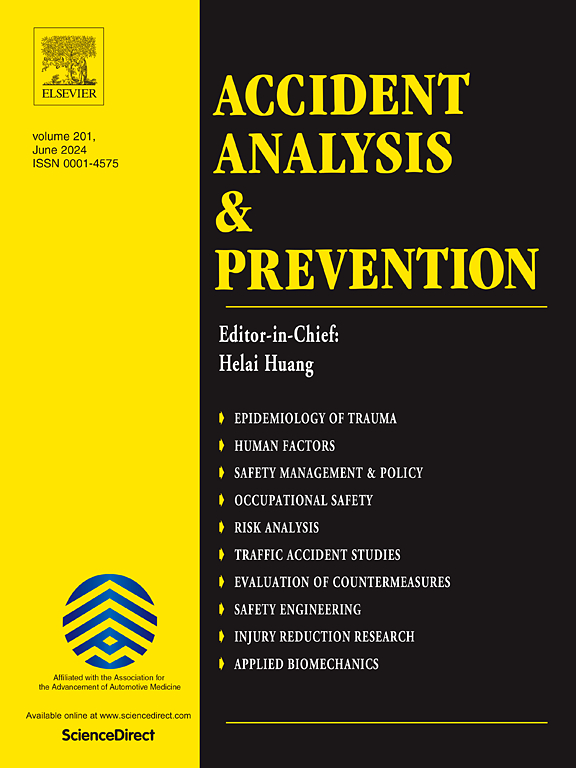Joint analysis of crash injury severities for autonomous and conventional vehicles in mixed traffic environments: Application of random parameter bivariate probit model
IF 6.2
1区 工程技术
Q1 ERGONOMICS
引用次数: 0
Abstract
Autonomous vehicles (AVs) are expected to significantly enhance road safety in the future. However, until fully autonomous driving systems are widely adopted, mixed traffic with AVs and conventional vehicles (CVs) will remain a typical feature of roadways. Consequently, it is crucial to understand how roadway and built environment factors impact traffic safety in mixed traffic settings. This study proposes a joint model to analyze crash injury severity for both autonomous and conventional vehicles within a unified framework. A random parameter bivariate probit model (RBP) is used as the methodological approach, as it accounts for the correlation between injury outcomes for AVs and CVs, while also capturing unobserved heterogeneity among the factors influencing safety. The model is developed using a dataset of 699 paired crashes, involving both AVs and CVs, occurring in proximity to each other in mixed traffic conditions in California. For comparison, both a random parameters univariate probit model (RUP) and a bivariate probit model (BP) are also developed. Model comparison results demonstrate that the proposed RBP model outperforms both the RUP and BP model in terms of explanatory power and goodness-of-fit. The parameter estimates reveal divergent effects of crash type and cause, natural environmental conditions, roadway features, and built environment factors on injury severity for autonomous and conventional vehicle crashes. The key results include: (1) A primary cause of AV crashes is the failure of CV drivers to respond appropriately or in a timely manner to unexpected changes in AV behaviors. (2) Adverse natural conditions, such as dark, pose a greater safety risk for AVs compared to CVs. (3) Road features with complex traffic conditions—such as Y-shaped intersections, traffic signals, and areas where lanes merge or diverge—are associated with a higher likelihood of injury in AV crashes, whereas these factors do not significantly affect injury severity in CV crashes. (4) Built environment factors related to vulnerable road users and public transportation infrastructure, such as crosswalks, schools, bus stops, and metro stops, exhibit notably heterogeneous effects on injury severity in AV crashes. The findings of this study have important implications for developing targeted strategies to enhance safety in mixed traffic environments. These strategies include establishing effective communication systems between autonomous and conventional vehicles, improving obstacle detection and performance in low-visibility conditions, and ensuring well-equipped road infrastructure for vulnerable road users.
混合交通环境下自主车辆与常规车辆碰撞损伤严重程度联合分析:随机参数二元probit模型的应用
自动驾驶汽车(AVs)有望在未来显著提高道路安全。然而,在完全自动驾驶系统被广泛采用之前,自动驾驶汽车和传统车辆(cv)的混合交通仍将是道路的典型特征。因此,了解道路和建筑环境因素如何影响混合交通环境下的交通安全至关重要。本研究提出了一个联合模型,在统一的框架内分析自动驾驶和传统车辆的碰撞损伤严重程度。随机参数双变量概率模型(RBP)被用作方方学方法,因为它解释了自动驾驶汽车和CVs损伤结果之间的相关性,同时也捕获了影响安全性的因素之间未观察到的异质性。该模型是使用699个配对碰撞的数据集开发的,其中包括自动驾驶汽车和自动驾驶汽车,这些碰撞发生在加利福尼亚州的混合交通条件下。为了进行比较,还开发了随机参数单变量概率模型(RUP)和双变量概率模型(BP)。模型比较结果表明,所提出的RBP模型在解释力和拟合优度方面优于RUP和BP模型。参数估计揭示了碰撞类型和原因、自然环境条件、道路特征和建筑环境因素对自动驾驶汽车和传统汽车碰撞伤害严重程度的不同影响。主要研究结果包括:(1)自动驾驶汽车碰撞的主要原因是自动驾驶汽车驾驶员未能对自动驾驶汽车行为的意外变化做出适当或及时的反应。(2)黑暗等恶劣自然条件对自动驾驶汽车的安全风险大于自动驾驶汽车。(3)具有复杂交通条件的道路特征(如y形十字路口、交通信号和车道合并或分叉区域)与自动驾驶汽车碰撞中较高的受伤可能性相关,而这些因素对自动驾驶汽车碰撞中的伤害严重程度没有显著影响。(4)与弱势道路使用者和公共交通基础设施相关的建成环境因素(如人行横道、学校、公交车站和地铁车站)对自动驾驶汽车碰撞伤害严重程度的影响具有显著的异质性。本研究结果对制定有针对性的策略以提高混合交通环境中的安全具有重要意义。这些策略包括在自动驾驶车辆和传统车辆之间建立有效的通信系统,改善低能见度条件下的障碍物检测和性能,并确保为弱势道路使用者提供装备精良的道路基础设施。
本文章由计算机程序翻译,如有差异,请以英文原文为准。
求助全文
约1分钟内获得全文
求助全文
来源期刊

Accident; analysis and prevention
Multiple-
CiteScore
11.90
自引率
16.90%
发文量
264
审稿时长
48 days
期刊介绍:
Accident Analysis & Prevention provides wide coverage of the general areas relating to accidental injury and damage, including the pre-injury and immediate post-injury phases. Published papers deal with medical, legal, economic, educational, behavioral, theoretical or empirical aspects of transportation accidents, as well as with accidents at other sites. Selected topics within the scope of the Journal may include: studies of human, environmental and vehicular factors influencing the occurrence, type and severity of accidents and injury; the design, implementation and evaluation of countermeasures; biomechanics of impact and human tolerance limits to injury; modelling and statistical analysis of accident data; policy, planning and decision-making in safety.
 求助内容:
求助内容: 应助结果提醒方式:
应助结果提醒方式:


